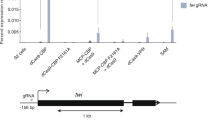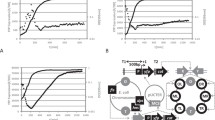Summary
We have examined the relative contributions of MCM1 and STE12 to the transcription of the a-specific STE2 gene by using a 367 by fragment from the STE2 5′-noncoding region to drive expression of a reporter lacZ gene. Mutation of the MCM1 binding site destroyed MCM1 · α2-mediated repression in α cells and dramatically reduced expression in a cells. The residual expression was highly stimulated by exposure of cells to pheromone. Likewise, the loss of STE12 function reduced lacZ expression driven by the wild-type STE2 fragment. In the absence of both MCM1 and STE12 functions, no residual expression was observed. Thus, the STE2 fragment appears to contain two distinct upstream activation sequences (UASs), one that is responsible for the majority of expression in cells not stimulated by pheromone, and one that is responsible for increased expression upon pheromone stimulation. In further support of this idea, a chemically synthesized version of the STE2MCM1 binding site had UAS activity, but the activity was neither stimulated by pheromone nor reduced in ste12 mutants. Although transcription of aspecific genes also requires both MCM1 and STE12, these genes differ from a-specific genes in that they have a single, MCM1-dependent UAS system. The activity of the minimal 26 by UAS from the α-specific STE3 gene was both stimulated by pheromone and reduced in ste12 mutants. These data suggest that at α-specific genes STE12 and MCM1 exert their effects through a single UAS.
Similar content being viewed by others
References
Achstetter T (1989) Regulation of a-factor production in Saccharomyces cerevisiae: a-factor pheromone-induced expression of the MFχl and STE13 genes. Mol Cell Biol 9:4507–4514
Ammerer G (1990) Identification, purification and cloning of a polypeptide (PRTF/GRM) that binds to mating-specific promoter elements in yeast. Genes Dev 4:299–312
Becker DM, Guarente L (1990) High efficiency transformation of yeast by electroporation. Methods Enzymol 194:182–187
Beggs JD (1978) Transformation of yeast by a replicating hybrid plasmid. Nature 275:104–109
Beggs JD (1981) Multi-copy yeast plasmid vectors. Proc Alfred Benzon Symp 16:383–389
Bender A, Sprague GF Jr (1987) MATα1 protein, a yeast transcription activator, binds synergistically with a second protein to a set of cell-type-specific genes. Cell 50:681–691
Bostein D, Falco SC, Stewart SE, Brennan M, Scherer S, Stinchcomb DT, Struhl K, Davis RW (1979) Sterile host yeast (SHY): a eukaryotec system of biological containment for recombinant DNA experiments. Gene 8:17–24
Casadaban MJ, Martinez-Arias A, Shapira SK, Chou J (1983) β-Galactosidase gene fusions for analyzing gene expression in Escherichia coli and yeast. Methods Enzymol 100:293–308
Dolan JW, Kirkman C, Fields S (1989) The yeast STE12 protein binds to the DNA sequence mediating pheromone induction. Proc Natl Acad Sci USA 86:5703–5707
Errede B, Ammerer G (1989) STE12, a protein involved in celltype-specific transcription and signal transduction in yeast, is part of protein-DNA complexes. Genes Dev 3:1349–1361
Fields S, Herskowitz I (1985) The yeast STE12 product is required for expression of two sets of cell-type specific genes. Cell 42:923–930
Fields S, Chaleff DT, Sprague GF Jr (1988) Yeast STE7, STE11, STE12 genes are required for expression of two sets of cell-type specific genes. Mol Cell Biol 8:551–556
Flessel MC, Brake AJ, Thorner J (1989) The MFα1 gene of Saccharomyces cerevisiae: Genetic mapping and mutational analysis of promoter elements. Genetics 121:223–236
Fried M, Crothers D (1981) Equilibrium and kinetics of lac repressor-operator interactions by polyacrylamide gel electrophoresis. Nucleic Acids Res 9:6505–6525
Garner M, Revzin A (1981) A gel electrophoresis method for quantifying the binding of proteins to specific DNA regions: Application to components of the E. colilactose regulatory system. Proc Natl Acad Sci USA 81:6442–6446
Hagen DC, Sprague GF Jr (1984) Induction of the yeast α-specific STE3 gene by the peptide pheromone a-factor. J Mol Biol 178:835–852
Hartig A, Holly J, Saari G, MacKay VL (1986) Multiple regulation of STE2, a mating-type-specific gene of Saccharomyces cerevisiae. Mol Cell Biol 6:2106–2114
Hartwell LH (1980) Mutants of Saccharomyces cerevisiae unresponsive to cell division control by peptide mating pheromone. J Cell Biol 85:811–822
Hayes TE, Sengupta P, Cochran GH (1988) The human c fos serum response factor and the yeast factors GRM/PRTF have releated DNA-binding specificities. Genes Dev 2:1713–1722
Herskowitz I (1988) Life cycle of the budding yeast Saccharomyces cerevisiae. Microbiol Rev 52:536–553
Herskowitz I (1989) A regulatory hierarchy for cell specialization in yeast. Nature 342:749–757
Inokuchi K, Nakayama A, Hishinuma F (1987) Identification of sequence elements that confer cell-type-specific control of MFal expression in Saccharomyces cerevisiae. Mol Cell Biol 7:3185–3193
Jarvis EE, Hagen DC, Sprague GF Jr (1988) Identification of a DNA segment that is necessary and sufficient for α-specific gene control in Saccharomyces cerevisiae: Implications for regulation of α-specific and a-specific genes. Mol Cell Biol 8:309–320
Jarvis EE, Clark KL, Sprague GF Jr (1989) The yeast transcription activator PRTF, a homolog of the mammalian serum response factor, is encoded by the MCM1 gene. Genes Dev 3:936–945
Johnson AD, Herskowitz I (1985) A repressor (MATα2 product) and its operator control expression of a set of cell-type-specific genes in yeast. Cell 42:237–247
Keleher CA, Goutte C, Johnson AD (1988) The yeast cell-typespecific repressor α2 acts cooperatively with a non-cell-typespecific protein. Cell 53:927–936
Keleher CA, Passmore S, Johnson AD (1989) Yeast repressor α2 binds to its operator cooperatively with yeast protein Mcm1. Mol Cell Biol 9:5228–5230
Kronstad JW, Holly JA, MacKay VL (1987) A yeast operator overlaps an upstream activation site. Cell 50:369–377
Kunkel TA, Roberts JD, Zakour RA (1987) Rapid and efficient site-specific mutagenesis without phenotypic selection. Methods Enzymol 154:367–382
McCaffrey G, Clay FJ, Kelsay K, Sprague GF Jr (1987) Identification and regulation of a gene required for cell fusion during mating of the yeast Saccharomyces cerevisiae. Mol Cell Biol 7:2680–2690
Passmore S, Elble R, Tye B-K (1989) A protein involved in minichromosome maintenance in yeast binds a transcription enhancer conserved in eukaryotes. Genes Dev 3:921–935
Sambrook J, Fritsch EF, Maniatis T (1989) Molecular cloning, second edition. Cold Spring Harbor Laboratory, Cold Spring Harbor, NY
Sanger F, Nicklen S, Coulson AR (1977) DNA sequencing with chain-terminating inhibitors. Proc Natl Acad Sci USA 74:5463–5467
Sauer RT, Smith DL, Johnson AD (1988) Flexibility of the yeast α2 repressor enables it to occupy the ends of its operator, leaving the center free. Genes Dev 2:807–816
Sherman F, Fink GR, Hicks JB (1986) Methods in yeast genetics. Cold Spring Harbor Laboratory, Cold Spring Harbor, NY
Sprague GF Jr (1990) Combinatorial associations of regulatory proteins and the control of cell type in yeast. Adv Genet 27: 33–67
Strazdis JR, MacKay VL (1983) Induction of yeast mating pheromone α-factor by α cells. Nature 305:543–545
Tan S, Ammerer G, Richmond TJ (1988) Interactions of purified transcription factors: Binding of yeast MATα1 and PRTF to cell type-specific, upstream activating sequences. EMBO J 7:4255–4264
Van Arsdell SW, Thorner J (1987) Hormonal regulation of gene expression in yeast. In: Granner D, Rosenfeld MG, Chang S (eds) Transcriptional control mechanisms. Liss, New York, pp 325–332
Vieira J, Messing J (1987) Production of single-stranded plasmid DNA. Methods Enzymol 153:3–11
Author information
Authors and Affiliations
Additional information
Communicated by D.Y. Thomas
Rights and permissions
About this article
Cite this article
Hwang-Shum, JJ., Hagen, D.C., Jarvis, E.E. et al. Relative contributions of MCM1 and STE12 to transcriptional activation of a- and α-specific genes from Saccharomyces cerevisiae . Molec. Gen. Genet. 227, 197–204 (1991). https://doi.org/10.1007/BF00259671
Received:
Issue Date:
DOI: https://doi.org/10.1007/BF00259671




